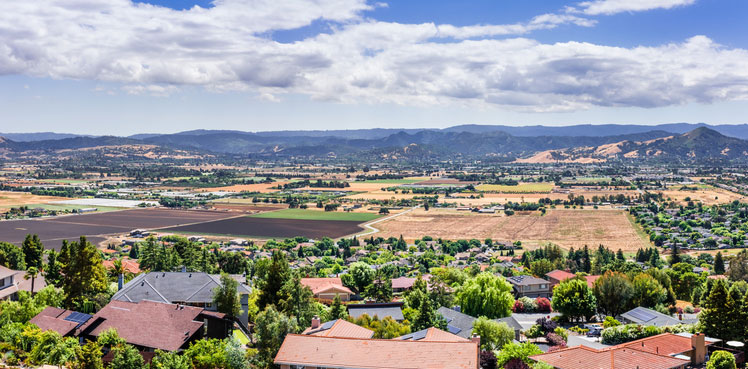Written by Helen Lewis
When you think of California, images of sunny beaches, bustling cities, and tech hubs might come to mind.
But beyond famous areas like San Francisco, Silicon Valley, and Los Angeles, a significant portion of California is rural, with sprawling farmlands and small towns.
Rural towns in California face unique challenges when it comes to healthcare. Unlike their urban counterparts, rural communities often struggle with a shortage of healthcare providers, long travel distances to the nearest clinic or hospital, and limited access to specialized medical services. This disparity makes it essential to address the healthcare needs of rural Californians to ensure they receive the same quality of care as those in the city.
The following article explores the critical role DNPs in California play for rural communities, helping everyone get access to healthcare through innovative technologies and their unique skill sets. We’ll also touch on whether or not DNPs can operate an independent practice in California – i.e., whether the certification is enough to practice as a medical doctor –, some of the positive developments in the field since the COVID-19 pandemic, salaries, and more.
Access for Everyone
Whether DNPs are in city hospitals, rural health clinics, or in a university classroom, one of a DNP’s main responsibilities involves acting as a bridge-builder: a skilled professional who can translate between medical doctors (MDs), registered nurses (RNs), and patients.
In a rural context, DNPs bring their skills in mediation and communication in the form of bringing high-quality professional-level medical skills into communities that may normally struggle to access regular medical attention.
One innovative approach to bridging this gap is the growing use of telemedicine.
With telemedicine, patients in remote areas can have virtual consultations with doctors, eliminating the need for long commutes and providing timely access to medical advice and specialist consultations that might otherwise be out of reach.
Additionally, mobile health clinics bring essential services directly to the communities that need them most. These mobile units can offer preventive care, vaccinations, and routine check-ups, reducing the burden on rural residents and improving overall health outcomes.
The Differences in Healthcare Between Rural and Non-Rural Settings
Rural areas often suffer from a shortage of healthcare providers, meaning residents might have to travel long distances to see a doctor or specialist.
This can result in delays in receiving care, which can be detrimental in urgent or chronic health situations. Additionally, rural healthcare facilities may not have the same level of resources or advanced medical technologies as urban hospitals, limiting the scope of care they can provide.
On the other hand, non-rural, or urban, healthcare typically benefits from a higher density of healthcare providers and facilities, making access more convenient for patients. Urban areas are more likely to have large hospitals equipped with the latest technology and a wide range of specialized services. This allows for quicker diagnosis and treatment of medical conditions. Moreover, urban healthcare systems often have more robust support structures, such as public transportation and comprehensive insurance networks, which can further ease access to care for residents.
Another crucial difference is the socioeconomic factors affecting health outcomes. Rural populations tend to have lower incomes, higher rates of uninsured individuals, and higher incidences of chronic diseases compared to their urban counterparts. These factors can exacerbate health disparities, as people in rural areas might forgo necessary medical treatment due to cost or lack of insurance coverage. In contrast, urban residents, while still facing challenges, generally have better access to healthcare coverage and services, contributing to better overall health outcomes. Addressing these disparities requires targeted strategies to enhance healthcare delivery and support in rural areas, ensuring that everyone, regardless of their location, receives the care they need.
DNPs and Telecare

Through telecare, DNPs can extend their reach beyond traditional clinical settings, bringing high-quality healthcare to patients who might otherwise have limited access to professional medical advice and treatment.
Telecare, or telemedicine, involves the use of digital communication technologies to deliver healthcare services remotely. This approach has proven particularly beneficial in bridging the gap between rural and urban healthcare disparities.
For instance, a patient in a remote area can have a virtual appointment with a DNP, receiving expert guidance without the need for extensive travel. This not only saves time and money, but also ensures timely intervention, which is crucial for managing chronic diseases and preventing complications. Through the use of this technology, DNPs can conduct virtual examinations, prescribe medications, and follow up on treatment plans, making healthcare more accessible and continuous.
Telemedicine: How COVID Changed Access to Healthcare
As lockdowns and social distancing measures restricted in-person visits during the first years of the COVID-19 pandemic, both healthcare providers and patients rapidly embraced virtual consultations. This shift ensured that essential healthcare services continued uninterrupted, highlighting the convenience and accessibility of telemedicine. This has not only enhanced patient convenience but also ensured timely medical intervention, reducing the risk of complications from delayed care.
Today, we can see that the pandemic accelerated the integration of telehealth into routine care, prompting many healthcare systems to expand their virtual infrastructure. Even as regular hospital and doctor’s visits have resumed, telemedicine remains an attractive option, particularly for patients who may live in faraway areas, seniors, and patients with mobility issues.
As a result, remote consultations have become a lasting and essential feature of modern healthcare, offering a safe and effective alternative to traditional in-person visits.
The Pros and Cons of Working in Rural vs. Non-Rural Healthcare: Is It Worth It?
Thinking about a career in healthcare but unsure if you should stay in the city?
Both paths come with their own sets of perks and challenges, such as:
Pros of Working in Rural Healthcare:
- Personal Relationships: You'll get to know your patients really well, often becoming a trusted part of their lives.
- Broader Scope of Practice: With fewer specialists around, you'll get to handle a wider variety of cases and develop a diverse skill set.
- Community Impact: Your work can make a huge difference in the community, and you'll likely feel a strong sense of fulfillment.
Cons of Working in Rural Healthcare:
- Resource Limitations: Fewer resources and less access to advanced technology can make providing comprehensive care challenging.
- Increased Workload: With a shortage of healthcare providers, you might find yourself working longer hours and being on call more often.
- Isolation: Fewer colleagues and specialists around can lead to feelings of isolation and limited professional support. Living in a rural area might also mean fewer cultural and recreational activities, which could impact your personal life.
Pros of Working in Non-Rural (Urban) Healthcare:
- Access to Resources: Plenty of advanced technology and a wide range of specialists to collaborate with.
- Professional Development: More opportunities for continuing education and professional growth.
- Lifestyle: Cities offer a rich array of cultural, social, and recreational activities.
Cons of Working in Non-Rural (Urban) Healthcare:
- High Patient Volume: The fast-paced environment can be overwhelming and lead to burnout.
- Complex Systems: Navigating large healthcare systems and bureaucracies can be frustrating.
- Less Personal Connection: With so many patients, it might be harder to build strong personal relationships.
- Higher Cost of Living: Cities tend to be more expensive to live in than rural areas, from rent costs to transportation, food, and utilities.
So, is it worth it? Ultimately, the decision comes down to what you value most in your career and personal life. If you thrive on close-knit community connections and a wide-ranging practice, rural healthcare might be your calling. If you prefer the hustle and bustle of a city, with top-notch resources and endless opportunities for growth, urban healthcare could be the way to go. Whichever path you choose, both have unique rewards and challenges that can lead to a fulfilling career in healthcare.
Can a DNP Practice Independently in California?
Traditionally, nurse practitioners in California have been required to work under the supervision of a physician, but there’s been a significant shift in recent years.
Thanks to Assembly Bill 890, which was signed into law in 2020, certain nurse practitioners, including DNPs, now have the ability to practice independently under certain conditions.
Starting January 1, 2023, nurse practitioners who meet specific requirements can practice independently without physician supervision in California. To qualify, NPs must:
- Complete a “transition to practice” period of at least three years or 4,600 hours of clinical practice in California.
- Obtain national board certification in one of the six primary categories: Family/Individual across the lifespan, Adult-Gerontology (primary or acute care), Neonatal, Pediatrics (primary or acute care), Women’s Health/Gender-Related, or Psychiatric-Mental Health across the lifespan.
- Work in settings where one or more physicians practice for at least three years before advancing to a status that allows full independent practice without any setting restrictions.
Under this new law, qualified nurse practitioners can perform tasks such as conducting advanced assessments, ordering and interpreting diagnostic procedures, establishing diagnoses, and prescribing medications.

This change is a big win for healthcare accessibility, especially in underserved areas.
Independent practice allows DNPs to set up their own practices, prescribe medications, and offer a wider range of services directly to patients. It also helps fill gaps in primary care, particularly in rural and remote communities where medical resources are often limited.
How Much Does A DNP Make in California?
If you’re a Doctor of Nursing Practice (DNP) considering working in California, you’ll be pleased to learn that the state offers some of the highest salaries in the country for nurse practitioners.
On average, a DNP in California can expect to make around $158,130 per year, which is significantly higher than the national average for nurse practitioners. This elevated salary reflects the high demand for healthcare professionals in the state, especially in metropolitan areas like San Francisco, San Jose, and Los Angeles, where DNPs can earn even more. For instance, in San Francisco, DNPs can make approximately $190,070 annually, while in San Jose, the average salary is about $199,630.
However, these impressive salaries do come with considerations. The cost of living in California is among the highest in the nation, which can offset the benefits of a higher income. Additionally, salaries can vary significantly depending on the specific region and the healthcare setting. Urban areas tend to offer higher wages compared to rural regions, but they also come with a more competitive job market and potentially higher stress levels due to the volume of patients. Despite these factors, the financial prospects for DNPs in California remain strong, making it a lucrative state for advanced practice nurses.
2023 US Bureau of Labor Statistics salary and employment figures reflect state data, not school-specific information. Conditions in your area may vary. Data accessed September 2024.

